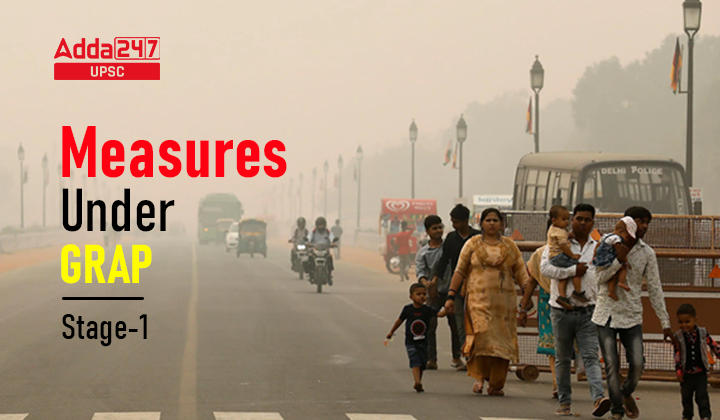Table of Contents
Why in news?
- The Commission for Air Quality Management (CAQM) said on October 5 that measures under ‘Stage-1’ of the Graded Response Action Plan (GRAP) will be enforced in the NCR with immediate effect.
- The order came after Delhi’s AQI deteriorated to be in the ‘poor’ category.
What is GRAP?
- The Graded Response Action Plan(GRAP) is a set of emergency measures that kick in to prevent further deterioration of air quality once it reaches a certain threshold.
- Stage 1 of GRAP is activated when the AQI is in the ‘poor’ category (201 to 300), and On Wednesday, for instance, the AQI in Delhi was 211.
- The second, third and fourth stages will be activated three days ahead of the AQI reaching the ‘very poor’ category (301 to 400), ‘severe’ category (401 to 450) and ‘severe +’ category (above 450) respectively.
- For this, the CAQM is relying on air quality and meteorological forecasts by the Indian Institute of Tropical Meteorology (IITM) and the India Meteorological Department (IMD).
- Measures being imposed under the previous categories will continue even when the subsequent category is activated, that is, if measures under Stage-2 are activated, measures under Stage-1 will continue to remain in place.
What is Air Quality Early Warning System?
- India Meteorological Department in collaboration with Indian Institute of Tropical Meteorology (IITM) and the National Centre for Medium-Range Weather Forecasting (NCMRWF) has implemented Air Quality Early Warning System to predict extreme air pollution events and give alerts to take necessary steps as per Graded Response Action Plan of the Government of India.
- The high-level objective of this system is to enable and provide air quality forecasting and information services in a globally harmonized and standardized way tailored to the needs of society and policymakers.
How is the GRAP different this year?
- The CAQM revised the Graded Response Action Plan earlier this year.
- The GRAP was first notified in January 2017 by the Ministry of Environment, Forest and Climate Change. This was based on a plan that was submitted by the Central Pollution Control Board (CPCB) in November 2016.
- According to the notification, the task of implementing the GRAP fell on the now dissolved Environment Pollution (Prevention and Control) Authority for the NCR. From 2021 onwards, the GRAP is being implemented by the CAQM.
- In the version of the GRAP that was notified in 2017, measures kicked in after pollution concentrations reached a certain level.
- This year, measures are pre-emptive and will kick in based on forecasts in an attempt to prevent the AQI from deteriorating further.
- The older version of the GRAP was enforced based only on the concentration of PM2.5 and PM10.
- This year, GRAP is being enforced based on the AQI, which takes other pollutants also into account, such as ozone, sulphur dioxide and oxides of nitrogen.
Who will implement and enforce the GRAP?
- The CAQM has constituted a sub-committee for the operationalization of the GRAP.
- The sub-committee is required to meet frequently to issue orders to invoke the GRAP.
- The orders and directions of the CAQM will prevail in case of any conflict between directions issued by the State governments and the CAQM.
- Measures under the different categories of the plan are to be enforced by the pollution control boards of the NCR states and the concerned departments and agencies, including the traffic police, the Transport Department and road-owning and construction agencies.
- Actions under Stages II, III and IV will be invoked three days in advance of the AQI reaching the projected level



 TSPSC Group 1 Question Paper 2024, Downl...
TSPSC Group 1 Question Paper 2024, Downl...
 TSPSC Group 1 Answer key 2024 Out, Downl...
TSPSC Group 1 Answer key 2024 Out, Downl...
 UPSC Prelims 2024 Question Paper, Downlo...
UPSC Prelims 2024 Question Paper, Downlo...




